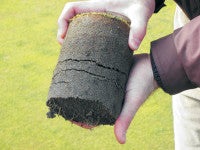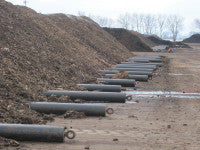Are you choosing your sand correctly?
 All sports surfaces require maintenance inputs in the form of feeding, irrigation, aeration and, of course, surface treatments such as topdressing; all of these are advised and recommended to achieve a top class finish, whatever division or leaguer or class of surface you are preparing.
All sports surfaces require maintenance inputs in the form of feeding, irrigation, aeration and, of course, surface treatments such as topdressing; all of these are advised and recommended to achieve a top class finish, whatever division or leaguer or class of surface you are preparing.
When looking for information, on bulk materials in particular, the usual options all concentrate their attention on the sand content of topdressing and rootzone alike. Okay, given that, in most cases, this makes up 70-95% of the overall mix, this approach is acceptable and expected; but what about the plant's requirements for macro and micro nutrients, and even mycorrhiza, the actually tool that holds tight onto nutrients and, in fact, actually attracts them to the plant's root system?
Given that sand is, essentially, an inert material offering no nutrient value at all, merely in fact a drainage medium when fully considered and, on a well balanced sand, also a good home, having both air and water pore space. Sand though is like a house without furniture, or gas and electric.
In terms of a rootzone situation for instance, if you decided to 'save costs' and build a new green using only straight sand, what would the ongoing implications be?
If we take a medium grade sand, where the majority of the particles fall between .25 and .150 microns, with very little below 0.075 microns, this would, typically, have a percolation rate of around 700mm/hour!
Imagine how dry the surface would be... brilliant, or what?
Well no, not really, because what happens in an ideal world, immediately after you've applied fertiliser, is that it rains and washes the feed into the profile. Given the open profile of our 'ideal' sand, the feed you have just applied will end up very quickly in the drainage carpet!!
So, what do we do to stop feed and irrigation water simply leaching straight through our rootzone?
Organic amendment is the simple answer. However, the tough question is - which one is best?
In the UK market there are currently three main options for amending a rootzone or topdressing mix. These are, Topsoil, Sphagnum Moss Peat and Green Compost.
I would like to tackle each independently and give their plus and negative points and then assess at the end that which, in my experience, is the best, not for all, but for the vast majority of applications.
Topsoil:
Plus: Availability
Negatives: Inconsistency; Price; Low nutrient value; High bulk density; High sand content; Clay/Silt content; Stone/Glass; Environment
Sphagnum Moss Peat:
Pluses: Low bulk density; Water holding capacity; Low ph value
Negatives: Price; Breaks down quickly; Virtually sterile - needs inputs; Environment
Green Compost (pas100/2005 certified):
Pluses: Low bulk density: Very consistent supply chain; High nutrient source; Proven to have and attract Mycorriza; Disease resistant; Drought resistant; Fibrous - resists compaction; Price; Availabilty
Disease resistant; Drought resistant; Fibrous - resists compaction; Price; Availabilty
Negative: Twiggy (10mm minus)
TopSoil:
In a blend, especially a rootzone mix, topsoil is added only to slow down the movement of water through the profile - it offers and has no other benefits to give. Most UK topsoils are, in themselves, 90% made of sand particles, usually medium, medium fine, very fine and silt/clay particles in particular. Yes, it is a widely available source and, yes, it is cheap, enabling the producers to maximise their profits. Topsoil is the most inconsistent source of organic amendment that is available. FACT!
From one side of a field to the other, much like most golf courses, the soil type changes and varies from sandy loam to silty clay loams yet, still, some manufacturers of sands in the UK are using topsoils in their mixes.
Sphagnum Moss Peat:
Sphagnum is still the most widely used organic in all USGA mixes - FACT.
It offers a short term nutrient sponge effect until it breaks down - in my experience, within 3-5 years. It is usually incorporated at a rate of around 10-15% by volume and is there only to slow down the loss of nutrients in sand dominated rootzones. It offers a low ph - typically 5.5-6 in most USGA mixes - and this is, of course, ideal for Bent grasses and some of the US species like Penncross etc. It is also quite light, rootzones averaging around 1.55t/m3, as opposed to topsoil rootzones usually 1.7-1.9t/m3.
Green Compost:
Used in the US for in excess of thirty years!
Proven to reduce the occurrence of a number of turf diseases, including Red Thread and Fusarium.
Does not breakdown in the rootzone profile, prevalent for 10-15 years.
Nutrient supply - offers an immediate feed source
Batch tested to ensure 100% consistent supply chain
Quality scheme assured - pas100/2005
Very low bulk density around 1.45- 1.5t/m3
Rootzone mixes with green compost,of varying blend ratios, have all indicated strong germination patterns and increased yield, alongside the added disease tolerance AND weight/cost saving.
We have supplied greens and tees mixes to a number of clubs and, indeed, football pitches, and some mixes have been down to 1:1 and still performed excellently in all weather, handling rain, lack of rain etc., all with the same results, all using green compost as the organic amendment.
Our research, in real time situations with real greenkeepers, has shown that green compost is the best performing AND the most consistent organic amendment available; it is also the most environmentally friendly and sustainable organic on the planet.
Andy Law, Managing Director
Whitemoss Eco Supplies Ltd
www.whitemosseco.org.uk
